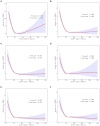Trends of serum 25(OH) vitamin D and association with cardiovascular disease and all-cause mortality: from NHANES survey cycles 2001-2018
- PMID: 38371503
- PMCID: PMC10869563
- DOI: 10.3389/fnut.2024.1328136
Trends of serum 25(OH) vitamin D and association with cardiovascular disease and all-cause mortality: from NHANES survey cycles 2001-2018
Abstract
Background: The focus of this survey is on survey data for adults aged 20 and above, covering nine survey cycles from 2001 to 2018. Additionally, the present study explored the correlation between vitamin D concentrations and both cardiovascular disease (CVD) and all-cause mortality.
Objective: The objectives of this study were to evaluate the trend of changes in the serum 25(OH)D concentration changes in US adults during the survey period, the prevalence of vitamin D deficiency, and the current status of vitamin D dietary intake and supplementation.
Methods: In-home health interviews were performed using meticulously designed questionnaires that gathered information on demographic details, socioeconomic conditions, dietary patterns, and overall health status. Health assessments were conducted in specially designed mobile centers.
Results: Survey data from 2001 to 2018 revealed a rise in serum 25(OH)D levels, from a weighted mean (95% CI) of 65.6 (63.8-67.4) nmol/L during 2001-2002 to 73.5 (70.4-76.5) nmol/L during 2017-2018, among US adults, while overall vitamin D deficiency rates remained stable (p = 0.152). Notably, in adults aged 20-39, 25(OH)D levels decreased (p = 0.002 for trend), and 25(OH)D deficiency increased (p = 0.003 for trend), especially among those with low incomes (deficiency >30%). Upon multivariable adjustment, an L-shaped relationship was found between serum 25(OH)D concentrations and both CVD and all-cause mortality (p < 0.001 for nonlinearity), as corroborated by sensitivity analyses.
Conclusion: From 2001 to 2018, US adults experienced a significant increase in their serum 25(OH) D concentration. However, subgroups of individuals, including young adults and individuals with lower socioeconomic status, exhibited a heightened risk of 25(OH)D deficiency. Furthermore, an L-shaped relationship was found between 25(OH)D concentration and both all-cause and CVD mortality among US adults.
Keywords: CVD mortality; NHANES; all-cause mortality; serum vitamin D concentration; trends.
Copyright © 2024 Hu and Yang.
Conflict of interest statement
The authors declare that the research was conducted in the absence of any commercial or financial relationships that could be construed as a potential conflict of interest.
Figures

Similar articles
-
Association between serum 25-hydroxyvitamin D and vitamin D dietary supplementation and risk of all-cause and cardiovascular mortality among adults with hypertension.Nutr J. 2024 Mar 9;23(1):33. doi: 10.1186/s12937-024-00914-8. Nutr J. 2024. PMID: 38459491 Free PMC article.
-
Association of serum 25-hydroxyvitamin d concentrations with all-cause and cause-specific mortality among individuals with depression: A cohort study.J Affect Disord. 2024 May 1;352:10-18. doi: 10.1016/j.jad.2024.02.018. Epub 2024 Feb 9. J Affect Disord. 2024. PMID: 38341158
-
Association of Serum 25-Hydroxyvitamin D Concentrations With All-Cause and Cause-Specific Mortality Among Individuals With Diabetes.Diabetes Care. 2021 Feb;44(2):350-357. doi: 10.2337/dc20-1485. Epub 2020 Nov 8. Diabetes Care. 2021. PMID: 33168652
-
Serum 25(OH)D Concentration, Vitamin D Supplementation, and Risk of Cardiovascular Disease and Mortality in Patients with Type 2 Diabetes or Prediabetes: a Systematic Review and Dose-Response Meta-Analysis.Am J Clin Nutr. 2023 Sep;118(3):697-707. doi: 10.1016/j.ajcnut.2023.07.012. Epub 2023 Jul 18. Am J Clin Nutr. 2023. PMID: 37467897
-
Vitamin D and Calcium: A Systematic Review of Health Outcomes (Update).Evid Rep Technol Assess (Full Rep). 2014 Sep;(217):1-929. doi: 10.23970/AHRQEPCERTA217. Evid Rep Technol Assess (Full Rep). 2014. PMID: 30313003
Cited by
-
Joint association of vitamin D deficiency and sleep disorders with cardiovascular mortality: a prospective cohort study.Front Nutr. 2025 Apr 11;12:1514529. doi: 10.3389/fnut.2025.1514529. eCollection 2025. Front Nutr. 2025. PMID: 40290660 Free PMC article.
-
Sex and race disparities in the association between work characteristics and vitamin D deficiency: findings from the National Health and Nutrition Examination Survey, 2005-2010.Occup Environ Med. 2024 Aug 16;81(7):339-348. doi: 10.1136/oemed-2024-109473. Occup Environ Med. 2024. PMID: 38955482 Free PMC article.
-
Vitamin D Status in the Adult Population of Romania-Results of the European Health Examination Survey.Nutrients. 2024 Mar 16;16(6):867. doi: 10.3390/nu16060867. Nutrients. 2024. PMID: 38542778 Free PMC article.
-
Sex differences and testosterone interfere with the structure of the gut microbiota through the bile acid signaling pathway.Front Microbiol. 2024 Oct 18;15:1421608. doi: 10.3389/fmicb.2024.1421608. eCollection 2024. Front Microbiol. 2024. PMID: 39493843 Free PMC article.
-
Higher dietary vitamin D intake influences brain and mental function in elderly Americans: a cross-sectional analysis.Front Nutr. 2025 Apr 9;12:1564568. doi: 10.3389/fnut.2025.1564568. eCollection 2025. Front Nutr. 2025. PMID: 40271436 Free PMC article.
References
LinkOut - more resources
Full Text Sources

